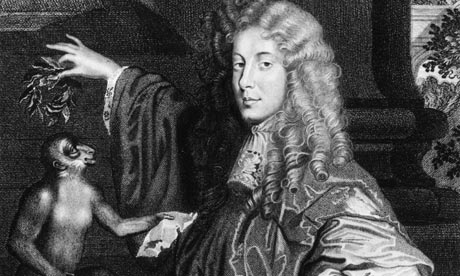
When I visited the Cotswold village of East Adderbury recently, there was still snow on the ground and the remnants of a snowman on the village green. It looked like a Christmas card. Or, with its honey-coloured cottages and the leaded windows of the Red Lion pub looking out on the (half-white) green, a vision of the genteel England that John Major was once so keen to evoke.
But closer inspection of The Red Lion revealed another side to this village. Maybe even a hint of the kind of sleaze that Major was once so desperate to conceal.
This intimation of naughtiness can be seen on an old pub sign, now banished to a back yard, paint peeling, but still clearly legible:
Red Lion: Posting Inn & Tavern
Renowned Bill of Fayre -
Strong ales & all sorts of foreign
And other things very reasonable
Fetching wenches
Strong ale and fetching wenches: This was the side of Adderbury that I had come to investigate.
It was here – in Adderbury House, conveniently near the pub - that John Wilmot, the Secnd Earl of Rochester, had his country seat. All Shakespearean puns in that sentence are, I'm afraid, fully intended, since this was where the famous "profane wit" lodged his long-suffering wife. To her he wrote the sugared words:
When wearied with a world of woe,
To thy safe bosom I retire,
Where love and peace and truth does flow,
May I contented there expire.
But when he did bother to visit his wife in Adderbury, he had more pressing concerns than "peace and truth". He had, for instance, to attend to the important business of dressing up as a tinker, trailing around the neighbouring villages offering to look at householders' pots and pans – and then knocking out their bottoms. When in more self-reflective moods, he liked to dress up as a tramp, go out to meet other genuine hobos in the locality and encourage them to criticise the stinginess of the local aristo; namely, the second Earl of Rochester. As soon as he'd tricked them into insulting him, he'd reveal his true identity and then have them dunked into a barrel of beer as punishment.
Such acts show the same subtlety and oh-so-unfunny Bullingdon-Club-style humour that characterise most of Wilmot's poetry. Indeed, he is an unusually bad versifier for someone who has entered the ranks of the immortals. But for a few smart sallies against Charles II, he generally reads like a ruder, crueller version of Pam Ayres – which is to say, pretty awful. His doggerel is characterised by clanging rhymes, trite sentiment and misogynist bullying.
There's some snickering to be had at the cast list of Sodom (the supposed rudest play ever, which is generally attributed to the errant earl): Bolloximian, King of Sodom; Cuntigratia, his queen; Prickett, young Prince; Fuckadilla, Maid of Honour. Yet the play itself is murderously boring, even though it's full of drinking and "swiveing" and lines like: "Let Merkin, sir, be banished from the court."
Perhaps it shouldn't be held against Rochester that most of his poetry isn't much cop. He didn't write it for publication, after all, and didn't expect to be judged on it hundreds of years later. Less easy to defend is the fact that he was a bit of a bastard. His enduring popularity seems strange to me and I'm certainly not the first to be baffled by a visit to Adderbury. On 9 July 1739, Alexander Pope did considerably better than me and secured an invitation to Adderbury House itself, which I glimpsed only from the end of a long drive. He even slept upon Rochester's bed whereupon he proclaimed:
With no poetic ardour fir'd
I press the bed where Wilmot lay:
That here he lov'd, or here expir'd,
Begets no numbers grave or gay.
The thing you will have noticed here is that the visit did inspire some "numbers" from Pope. And here I am too, trying to write this blog. There's obviously something about the man. It is hard to define quite what. Maybe, that streak of rebellion that saw him constantly insulting the king he was also so desperate to impress? Maybe his 17th-century attempts at rock'n'roll excess? Maybe the legend of his dying young, even if he had a very ugly syphilis-ridden corpse? Or maybe I'm missing something in his poetry? Over to you.

